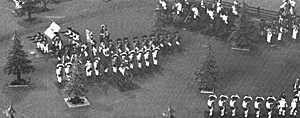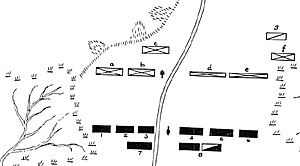 The battle of Camden has been called the most
disastrous defeat ever suffered by an American Army.
Curious to see, if possible, how this calamity occured I
persuaded our wargames group to refight the battle. The
British players were Ken Bunger and Mitch Allen, the
Americans Howard Wigger and Steve Lindholm. We used
Ken's TRICORNE rules. The armies were placed on the
table in their historical deployment (see map).
The battle of Camden has been called the most
disastrous defeat ever suffered by an American Army.
Curious to see, if possible, how this calamity occured I
persuaded our wargames group to refight the battle. The
British players were Ken Bunger and Mitch Allen, the
Americans Howard Wigger and Steve Lindholm. We used
Ken's TRICORNE rules. The armies were placed on the
table in their historical deployment (see map).
The plans adopted by each side were simple. Ken decided to send Rawdon's Brigade, reinforced by the Tory militia, forward to fix the Continentals in position. Webster's Brigade was to attack the American militia, defeat them, then turn to the left and roll up the Continentals.
On the American side Howard, knowing the battlefield endurance of his militia was limited and that he had too few regulars to attempt an attack of his own, decided to stand on the defensive. The Maryland Division was ordered to advance a short distance in order to provide room for the artillery to wheel back so it could cover the front of the North Carolina militia with enfilade fire and, at the same time, protect the flank of the Marylanders. On the left end of the line the light infantry was sent into the swamp to flank any British sent against the Virginia militia. Armand's Legion was directed to support the Virginians.
The battle began with a general advance on the part of the British and with the movement of Tarleton's Horse to the front of Webster's Brigade. The Horse shook out into a line and charged the Virginians. The Virginians stood firm and delivered a partial volley [1] as the Horse came to within twenty yards of their line. At the same time the cavalry received scattered fire [2] from the swamp to their right. Disconcerted by the volley, and worried about the unknown force on their flank, Tarleton's cavalry pulled up short of the Virginians and fell back to where they could receive support from the infantry. [3] Armand's Horse, seeing the British cavalry retreating, immediately launched a charge. [4]
On the British left Rawdon's Brigade marched up to musket range and engaged the 2nd Maryland and the Delaware Regiment in a hot firefight. The British Legion Foot quickly wilted and fell out of the line and could not be induced by their officers to return to the fight. [5]
In the center the British artillery engaged the American artillery in an unequal duel but did manage to disorganize the guns' matrosses sufficiently to spoil the wheeling movement. By the time the guns started moving again the British infantry was in musket range and the artillerymen started dropping like leaves in the fall.
On the British right the 23rd, the 33rd, and the light infantry advanced without firing and, as soon as they came close enough, launched a bayonet charge. [6] The Carolinians resisted briefly. The Virginians took one look at the British bayonets and turned and ran. [7] That was it. The entire American left was gone. In the center the remaining artillery section was being dragged off the field by its crew in a desperate attempt to find a relatively secure place from which to fire. [8]
The beleagured Maryland Division was still holding firm on the right but time was clearly running out for them. De Kalb tried to swing the 1st Maryland around to join and cover the flank of the 2nd Maryland. Cornwallis saw the Marylander's open flank and threw the 71st at it. The Maryland Division crumbled. [9]
The battle could safely be called over. Not one unbroken American unit remained on the field, except for a handful of light infantrymen hiding in the swamp. There would be no organized resistance to the inevitable pursuit by Tarleton's cavalry. The second battle of Camden was "a most disastrous defeat."
NOTES
1. Cavalry does not have to test morale to initiate a charge. As soon as the cavalry entered its charge bound the infantry tested morale to see if it would stand. It did. Then Howard rolled on the "Firing at a Charge" table to see what fire effect multiplier the unit would use. For simplicity we were using only Column "A" of the chart. Howard rolled a -5" so the Virginians fired at 3/4 effect.2. The light infantry in the swamp fired at the cavalry as it passed. Since the target was available for less than half a period the infantry fired at half effect.
3. The cavalry, having received 5% casualties as it came in, had to test morale to see if it could close. It had morale minuses for being unformed (cavalry was limited to unformed formations in this game) and having enemy on the flank, and morale pluses for being in charge bound. The result of the morale test permitted the cavalry to falI back in good order.
4. This was a mistake. The British cavalry was falling back in good order, which meant it could turn and fight if it passed its morale test. It did. And, despite meeting the charge of Armand's Horse at the halt Tarleton's Horse won the melee (the miserable fighting ability of Armand's Horse helped the British considerably).
5. The Legion Foot received 5% casualties and took a morale test scoring "Fall Back Disorganized". We were experimenting with a couple of new rules that evening, one of which was that units that were disorganized as a result of a morale test would have to score a result of "Stand" or better on the morale table before they could reorder. The Legion Foot never managed to pass the test.
6. The Militia was limited to unformed order in this game and close order infantry which is charging unformed troops does not have to test morale to initiate a charge.
7. The Carolinians passed the morale test for being charged and stood and fought one round of melee, which they lost. The Virginians failed the morale test and ran before the British could close.
8. The section scored "Fall Back In Good Order" on a morale test.
9. The unit which was charged on the flank failed to make its morale. When it routed the remaining regiments, now below 1/4 strength because of firing casualties, tested morale for seeing a routing friendly unit and scored a "Fall Back Disorganized". The consensus was that the disorganized units would be easy game for the British.
AMERICAN ORDER OF BATTLE
General Gates, CiC (0 morale effect)
Maryland Division, Baron de Kalb (+ 3 morale effect)
- a. Delaware Regiment - 300 men
b. 2nd Maryland - 300 men
c. 1st Maryland - 300 men
Artillery: 2 6-pounders and 4 3-pounders
North Carolina Brigade, General Caswell (0)
- d. NC militia - 1125 men
Virginia Brigade, General Stevens (0).
- e. VA militia - 700 men
f. Porterfield's Light Infantry - 100 men Armand's Legion Foot - 75 men
g. Armand's Legion Cavalry - 75 men
BRITISH ORDER OF BATTLE
Lord Cornwallis, CiC (+ 1)
Rawdon's Brigade, Lord Rawdon (+ 1)
- 1. Royal NC Regiment - 300 men
2. British Legion Foot - 150 men
3. Volunteers of Ireland - 300 men
Artillery: 4 3-pounders
Webster's Brigade, Col Webster (+ 1)
- 4. 33rd Foot - 300 men
5. 23rd Foot - 300 men
6. Light Infantry - 300 men
Reserve
- 7. Tory militia - 300 men
8. 71st Foot - 250 men
British Legion Cavalry - 250 men

Back to Table of Contents -- Courier Vol. V #2
To Courier List of Issues
To MagWeb Master Magazine List
© Copyright 1984 by The Courier Publishing Company.
This article appears in MagWeb (Magazine Web) on the Internet World Wide Web.
Other military history articles and gaming articles are available at http://www.magweb.com